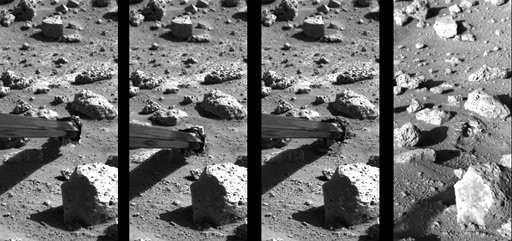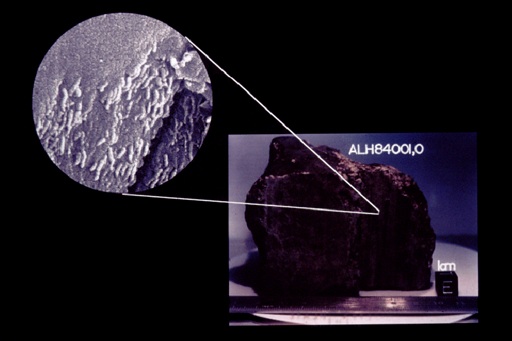The Surface of Mars
In the summer of 1976, two Viking spacecraft entered orbit around Mars. Two landers detached, descended, and touched down successfully.
DIGITAL EFFECT: Land On Mars
Approach Mars, and then fade the scene off to land on Mars, with a Martian panorama visible.
VISUAL 16 (still): Viking Lander

Soon, we saw the first photographs ever taken of the Martian landscape and could imagine standing next to one of the Viking landers, with rocks, sand and dust at our feet.
The surface of Mars looks like a rocky desert. There is no running water. The ground is very cold, even though the polar ice caps lie far away. The sky is colored salmon-pink. The air is extremely dry and thin. Many rocks are covered by a layer of fine red dust. The color of Mars is due to reddish minerals rich in iron-oxide—rust!
VISUAL 17 (still): Viking Digs a Trench
[Fade off the two Viking images.]

The Viking Landers each used a robot arm with a scoop at the end to dig into the Martian soil. This image shows how the digging arm gathered soil for experiments. A mini-chemistry lab on the landers searched for signs of microscopic life, but found no clear evidence of life on Mars.
Viking also measured weather on Mars, searched for Marsquakes, analyzed the air and the soil, and looked for magnetic particles. Mars’ atmospheric pressure is only 1/100 that of Earth, and the air is mainly carbon-dioxide. The average temperature on a midsummer afternoon is 30 degrees below zero, Celsius (-22°F). Dry ice can easily form on the Red Planet’s surface, especially in the south polar winter!
Mars’ environment today is even more hostile to life than we had thought from Earth-based observations. Still, the Vikings landed far from the ancient river channels, canyons, and polar ice caps. Might we yet find traces of microorganisms or even fossil remains of past lifeforms elsewhere on Mars?
Martian Meteorite
One intriguing possibility is that we may already have discovered evidence of ancient life on Mars embedded in a Martian meteorite.
VISUAL 18 (still): Mars Meteorite

[Fade off Mars Meteorite.]
The Viking analysis of Martian soil allows us to identify the Red Planet as the origin of a few rare meteorites such as this one, the Allan Hills meteorite (ALH 84001). A huge impact on Mars sixteen million years ago blasted fragments spaceward; and this one fell to Earth some 13,000 years ago. It was found in Antarctica. What a stroke of luck that we have found a new way to explore Mars with pieces of it dropping so “conveniently” to Earth.
Could these tiny, tube-like structures inside the Alan Hills meteorite be fossilized bacteria?
[Maybe.]
If so, they may have been alive on Mars several billion years ago! This idea is both tantalizing and controversial. The only way to settle the mystery is future expeditions to the Red Planet.

